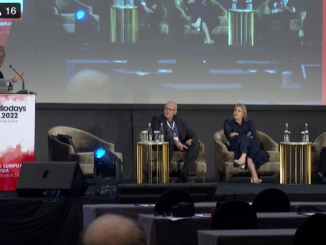
Fun Coast DAB launches in record time from the top of Blackpool Tower
Blackpool’s small-scale DAB radio multiplex has launched just three months after being awarded a licence by Ofcom. […]

Blackpool’s small-scale DAB radio multiplex has launched just three months after being awarded a licence by Ofcom. […]

TV news presenter Huw Edwards has written the foreword to a new book about Media Law for radio, podcasts and social media. […]

Sarah Grant has been appointed as Chief Finance Officer at WLR FM and Beat 102-103. […]

Podnews proprietor James Cridland surveyed some of the new technology being used by radio broadcasters and podcasters in a session today at RadioDays Asia.SpoolerSpooler is a new CMS for publishing audio that gives creators flexibility to edit and re-edit podcasts quickly and easily, making timely updates feasible in a way never possible before. Spoken, text based, instantly updatable content is the key to Spooler’s offering.The technology is built on the creation of individual digital story modules that can be updated and effortlessly packaged together in a way that is seamless and adaptive, resulting in a finished product that sounds as polished as highly-produced podcasts which can take many hours to create and edit.AdoriAdori allow visuals to be added easily to audio podcasts, for publication on Youtube. “Youtube is the second largest search engine on the internet, it has lots of audio, but needs pictures to make it even better.”Cridland expects that YouTube will increase its emphasis on podcasts in the near future. About half of the content on Youtube is audio content. He urged broadcasters to think about adding pictures and text that can be displayed if people are ‘watching’ the audio on YouTube, and gave the example of True Crime Reporter’s podcast as an example of how this can be done.Adori intends to be usable for TikTok and other platforms in time.SquadcastSquadcast is a Zoom-like tool that records at the person’s own end, ensuring that the quality of each speaker is consistently high, rather than the variable quality that is common in Zoom. Once the recording is finished, audio at the guest’s end will automatically be uploaded to teh broadcaster’s studio computer.Veritone VoiceArtificial voice company Veritone Voice uses familiar voices from the station team to deliver other content when they are not there. For example the synthetically generated voices of the breakfast team are used out of hours to deliver overnight weather, and then the voice reminds people that the team will be on air soon, at 6am.Other technologies mentioned include:The syndicated music countdown show 10 most wanted uses a system developed by the host Gav Richards that allows localisation content to be easily added into the syndicated show.RCS cloud based radio stations allow broadcasters to instantly expand their radio station offerings, such as a range of Kids stations offered by one broadcaster to serve its young audience. […]

Founder and Executive Creative Director, Eardrum, Ralph Van Dijk (pictured below), addressed Radiodays Asia, speaking about Love, the emotion that trumps all others, with the most successful brands those that are loved and shared at warp speed.He says consumers want to be engaged, entertained, and inspired, and the fastest way to a consumer’s heart is through their ears, but for too long “radio has been associated with one-night flings. It’s been the medium that shows up for one night, shouts a few things at you, and the advertising disappears after one night.” These ads have often tried too hard and are “…the audio equivalent of the cheap suit and too much cologne.” Ralph says audios lack of pictures gives it a massive advantage and “…advertisers on audio get to be with listeners all day, every day, at home, while they are on the move, in the most intimate and one on one environment.“We need to help our advertisers create long term campaigns that form long term relationships with our listeners. And if we do, those advertisers will come back time after time to radio.” He says barking lists of prices and talking at listeners doesn’t work, “…because 75% of consumers say they make their decisions based on emotions so if you can find a way to connect with your audience emotionally you are more than halfway to converting them into loyal customers.” […]

Talent recruitment has become harder due to increased competition from competitors poaching staff and social media providing a new avenue for people to build their personality profiles. There is now more competition for talent and wages. How are radio broadcasters coping and what strategies are they using to find and hold new talent? Steve Ahern, Head of ABU Media Academy led a panel discussion called ‘The Tussle for Talent’ with radio leaders to discover the extent of the problem and what they are doing about it.The panel included Duncan Campbell, Chief Content Officer, ARN, Australia, Amanda Lee, Content Director – Melbourne’s 101.9 The Fox, SCA, Australia and Abe Thomas, CEO, Big FM, India.Introducing the topic, Steve quoted the example of an anonymous employee who contacted Radio Today arguing for increased pay in an open letter to the industry. The reactions to it were polarized. Someone found it soul crushing to work really hard for perks which were few and far between and then hear that some people were earning obscene amounts of money, while someone else commented that if you don’t want to leave radio, you don’t need a six figure salary to “be comfortable”, learn what you can do with what you make.Steve then discussed comments from Malek Ali, Proprietor, BFM, Kuala Lumpur on what does it mean for retaining talent, now that people have other options. Is it a problem?Ali said: “Just the last few months, we have lost several people to other organisations seeking content creators. These are not media companies, just normal companies seeking content creator talent for their verticals. The only thing we can do is say it takes a team, not an individual, to create this great content, and then focus on our culture and environment to retain people. If an individual is motivated heavily by financial rewards and leave us, then we wish them well, but tell them to get back to us if anything changes.”Amanda said: “Yes, there’s a lot of other opportunities and not having to do the kind of hours we do in radio is a factor.”“You can make $40,000 a year with a YouTube channel as against $60,000 as a radio producer. You’ll stay in the business if you love it. It’s always been an issue,” said Duncan.Abe spoke of two new phenomena he has noticed after the pandemic, when there were a lot of job cuts and it changed the way talent looks at work as they seek a better work-life balance. “Ghosting is when people just disappear after their first salary and become uncontactable. The other trend is ‘Quiet Quitting’, when people just do the bare basic minimum to keep their job, there is no effort to try to achieve anything more,” he said.“In an industry with a shallow talent pool, it is our responsibility to help them develop talent,” said Duncan. […]
Copyright © 2025 | MH Magazine WordPress Theme by MH Themes